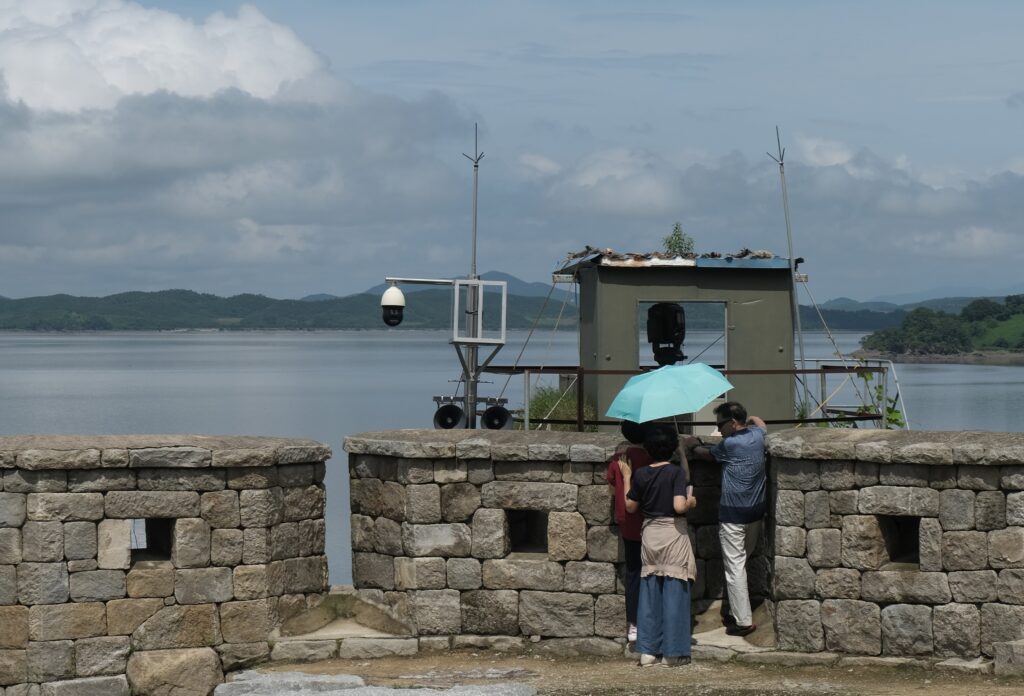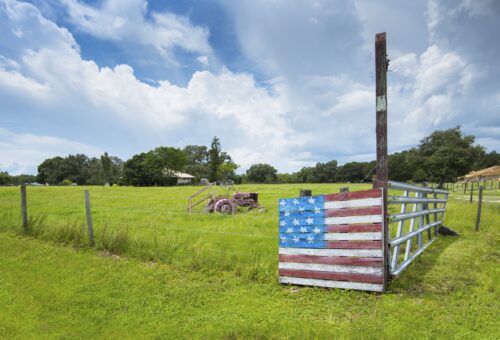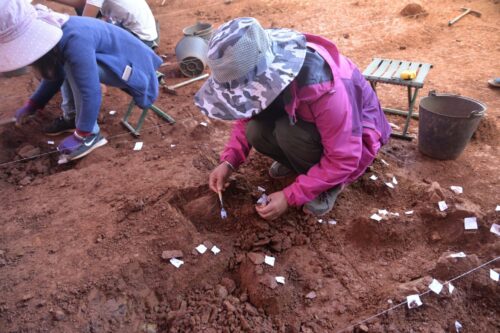Why Do Swallows Fly to the Korean DMZ?

WITHIN A FEW HOURS of landing in South Korea from Los Angeles on a hot July day in 2023, I boarded a bus with my suitcase and headed toward the Korean Demilitarized Zone (DMZ). Alongside other peace activists and organizers from near and far, I was going to an event commemorating the 70th anniversary of the signing of the armistice between North and South Korea on July 27, 1953—the day that began the longest ceasefire in history.
As the youngest person in the group—and the one who had traveled the farthest—many on the bus looked at me with curiosity as I tried not to give into fatigue from jet lag and the summer humidity. We came to a rest stop, and one lady in her 50s offered some water and her pocket handkerchief as ways to spark a conversation with me. She asked where I came from and why I had decided to join the event.
I initially gave her a modest introduction, telling her I was a researcher invested in the DMZ and antiwar movements in Korea. As an anthropologist, I had been conducting research and interviews at various sites and villages along the border for several years.
To learn more about the author’s work, listen on the SAPIENS podcast: “Ceasefire From the Earth and Sky.”
She was impressed, as most “young people” are not interested in the DMZ, peace, or unification. But she pressed on, sensing there was more to the story: why here and why now?
To that, I responded, “My grandpa is from over there,” pointing to the outlines of human habitation at one end of the estuary that meet the watery southwestern edge of the DMZ.
She wrapped her arms around my shoulder and said, “My father too.” She gently reached for my hands and introduced me to the group. “She’s a third-generation sirhyangmin (실향민). She’s traveled across the ocean to join us here today. She is a jebi (제비).”
The jebi, or barn swallow, has long captivated the cultural imagination of Koreans. Today many people displaced from the north, called sirhyangmin, view jebis with nostalgic affection. During the peak years of the Korean War (1950–1953) and after, many sirhyangmin resettled on the several islands in the estuary that make up Ganghwa County, creating new communities of northerners and southerners. Ganghwa residents have built nests across the islands for these birds, who spend the wintry months in southern climates across the Pacific but return to the estuary when warm again. For them, the jebi is at once a harbinger of hope, an assuring sign of return, and a symbol of available freedoms otherwise foreclosed for sirhyangmin.
Since 1953, the 250-kilometer-long artificial boundary of the DMZ has cut through the middle of the Korean peninsula. The demilitarized buffer zone created more than seven decades ago between the two warring states often feels impenetrable and permanent. However, the DMZ is livelier and more fluid than it seems. In fact, much of the DMZ crosses water—oceans, estuaries, and rivers. A quarter of this boundary falls upon the Han River estuary (한강하구), a “neutral” zone according to the Korean Armistice Agreement that established the DMZ. This status legally allows civilians to conduct life as they did before the war. Yet the military guard posts, pointed artillery, and surveilling soldiers that outline the estuary indicate a reality that is far from neutral.
In the midsummer heat, the receded waters of the estuary revealed a shallow depth. The person sitting next to me on the bus explained that in the past, before the division, when the waters ebbed, people would leave their boats behind and walk across the estuary to meet their family, business partners, and lovers. For centuries, the estuary was the source of life for the peninsula. The mineral richness in the estuarial mixing of fresh and salt water allowed the surrounding agriculture and wildlife to flourish. Today death awaits within its wiry edges, and only the birds are seen flying beyond the barbed wire.
LIKE THE JEBI, I, too, have spent most of my life unrooted on the warmer edges of the Pacific—in California. And I have come, again and again, to this estuary, only to find my relations here were as rooted as they were erratic.
The first time I saw the estuary was by accident during a family road trip from Seoul a year before the 70th anniversary of the armistice. Until then, I had little familiarity with the provinces of the north. I had come with my uncle, who had an intimate, lived grasp of this place. As I drove, he looked at me with a stunned, tearful face, requesting I pull to the side of the road. “Why did you bring me to this place?” he asked.
“What do you mean? Does this place mean something to you?” I replied, confused.
I tried to wrest an explanation from him inside the stopped car, unsure whether we should continue or return to Seoul. He finally explained how it was difficult for him to be reminded of how close we were to Hwanghae—the province we could glimpse across the border, where my grandfather and many displaced residents of the islands came from.
The closer we got to the heavily militarized border, the possibility of ever arriving seemed further away. The proximity had only brought him closer to a reality of a cemented division that he would rather not face. However, like the homing instinct of the jebi (귀소본능), a similar instinct within drew us back to the estuary.
As a Korean American, I had long been interested in the ongoing war that had uprooted my family. The war, which was supported by the U.S. military in the south, took the lives of as many as 3 million civilians and left millions more displaced. Researching the DMZ as an anthropologist has been a way to come to terms with this history. However, before coming to do my fieldwork, I had mostly kept an academic distance, engaging with the topic through research and scholarship that speaks to the lingering effects of Korea’s division. I had learned how communities across the north and south edges of the estuary were long connected through kinship and trade, but the Korean War turned them into enemies overnight. Even family members turned against one another, and many forged new associations with the communist north or “free” south.
This academic distance from the war began to collapse, however, when my uncle and I returned unexpectedly as jebis that day. And with each flight back, the distance continues to close itself as I meet more jebis from the same ancestral hometown.
ONE SUCH ENCOUNTER brought me to Kim Young-ae, a fellow swallow I met at a pro-democracy rally in Seoul. Kim, now 70 years old, is a second-generation sirhyangmin whose parents fled from Hwanghae Province during the war. Her family resettled across the border in Ganghwa, where she grew up and went to school. She had lived a long and impressive life as a scholar, diplomat, and community organizer both in Korea and abroad before retiring and returning to the estuary.
“It must have been fate,” Kim said of our meeting. The next week, she invited me to visit her on Gyodong, the island where she now lives in Ganghwa County. We spent the day together, sharing our life stories and the ways we had found ourselves drawn to the estuary. In her office, Kim showed me a map of the Korean peninsula, famously shaped like a rabbit with the eastern coast as the animal’s back.
Kim pointed at the estuary and asked, “Where are we?”
“The belly?” I responded.
“That’s right. This is where life begins, at the womb,” she said.
For Kim, the history of Korea and its relations with the world begins at the estuary. For centuries, the area served as an entryway for international trade and was heavily protected against foreign powers by the military. Much of the fortressing of the estuary began to crumble when the unequal Treaty of Ganghwa with Japan was signed in 1876. This paved the way for Korea to be subjected to colonial violence; Japan made Korea a protectorate in 1905 and fully annexed the country by 1910. After World War II, and with the end of the Japanese empire, Korean liberation was quickly curtailed with the beginning of the rising Cold War order, when the peninsula was divided along the 38th parallel and forcibly occupied by the Soviet Union in the north and the U.S. in the south.
In Ganghwa, where many northerners resettled, including Kim’s family, the years following the division were fraught with violent conflict, including between new and old residents. The estuary saw some of the bloodiest internecine violence and civilian massacres to have occurred during the Korean War.
While the islands remain heavily militarized today, the conflicts evolved into a quiet coexistence as the Cold War thawed in the last few decades of the 20th century. Today the islands are sparsely populated, mostly made up of an aging population that relies heavily on agriculture.
Kim asked me, “Do you know what the function of an estuary is?”
Not being able to recollect what I had surely learned in a high school environmental science course, I responded, “No, not really.”
“This is where salt and freshwater meet and purifies the water so that it can flow as freshwater into the country,” Kim explained. “Isn’t that remarkable?”
AS MUCH AS the estuary has served as a site of unspeakable colonial and wartime pain, it has also absorbed blood and tears so that life could live on.
For many decades, divisions within the communities seemed impossible to overcome. Bereaved families lived next to perpetrators, and surviving victims from the north were long silenced by the anti-communist regime in the south. Despite this shared pain, however, Ganghwa’s communities emerged as examples of how people of the estuary, torn apart by war, could come together again.
This is precisely what Kim and perhaps even the activists on that hot summer day sought to impress on me by naming me a fellow jebi—that, after all this time, we can still learn to relate to and live with one another.
While we sirhyangmin may be like the jebi, returning to rest and remember with others, unlike the bird, we cannot cross over the estuary. Perhaps that is why nests for the birds can be found all over the islands. Although we can’t go, the jebis may, in our stead, meet our loved ones.







































